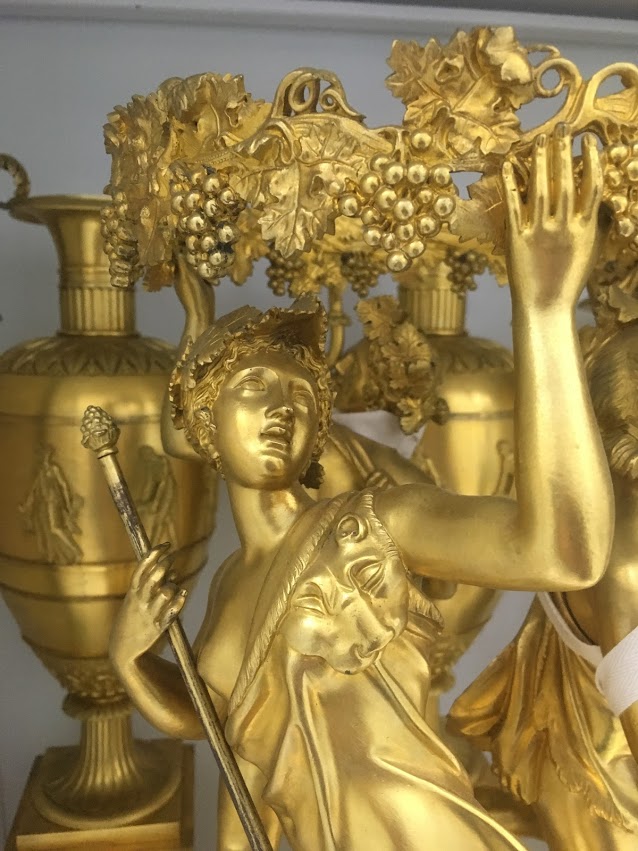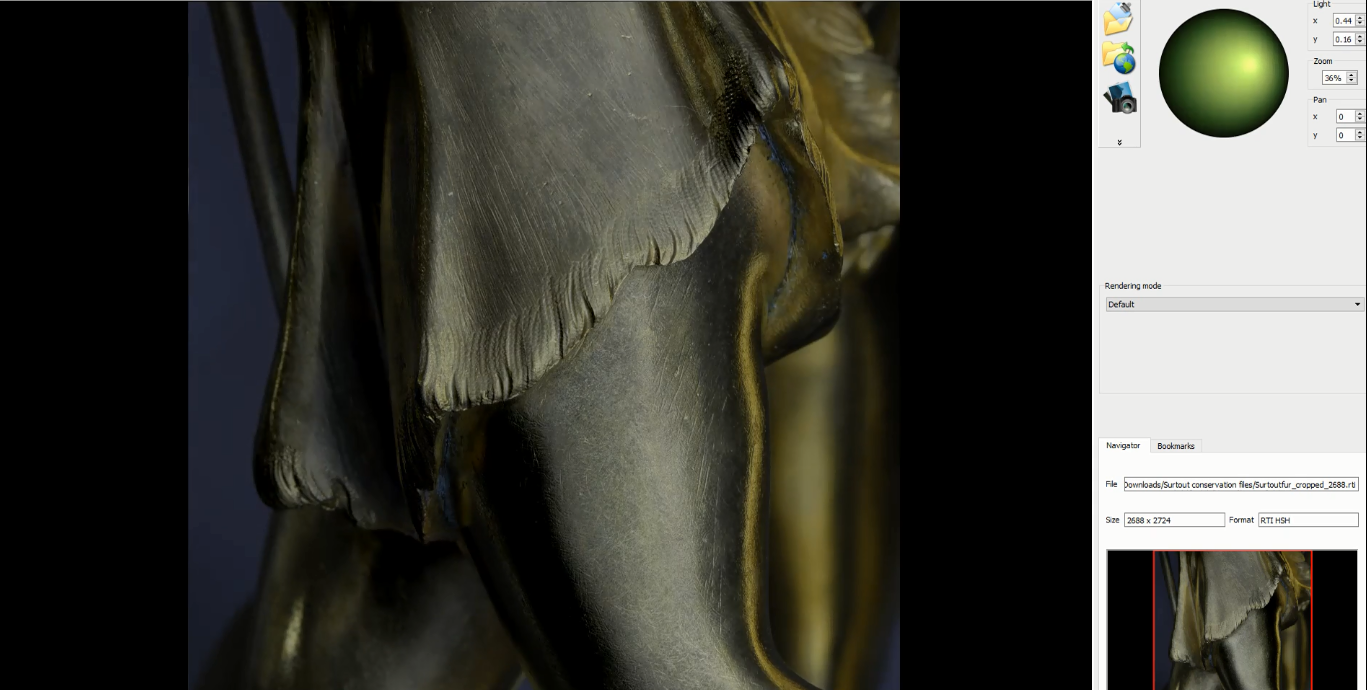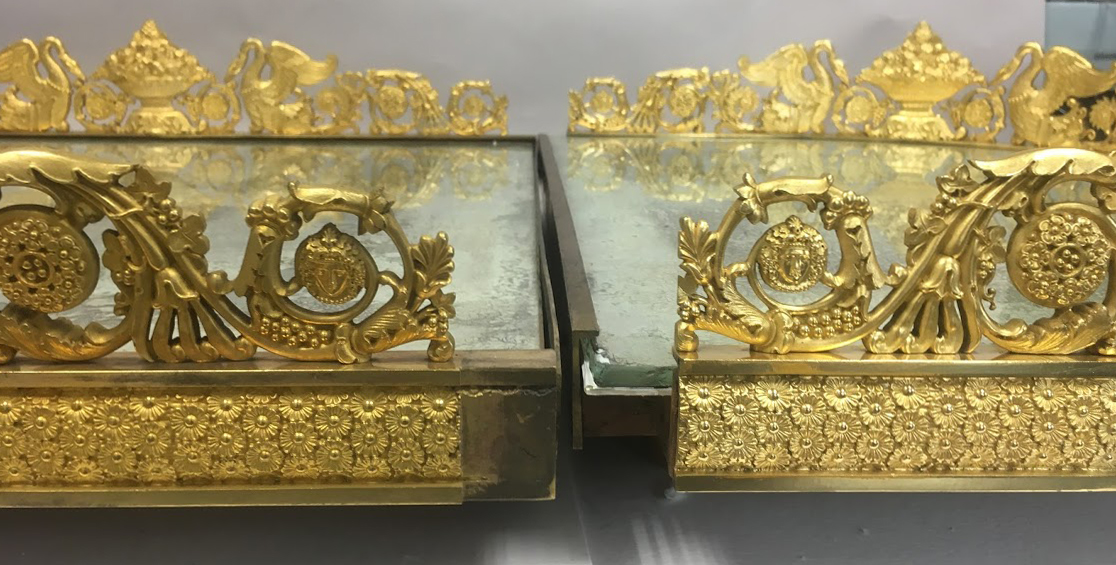Written by Jessica Walthew, Cooper Hewitt Objects Conservator, and Jakki Godfrey, Project Metals Conservator
Thanks to a generous gift from the Smithsonian Women’s Committee, Cooper Hewitt’s spectacular surtout de table centerpiece was the focus of a recent technical study and conservation treatment by the museum’s conservation department. In this series of posts, conservators will be sharing the results of the technical study, as well as more information on the making of the piece and its conservation.

Detail of gilt metalwork in the surtout de table centerpiece.
The metal components of the surtout de table were cast using either lost-wax or sand casting, techniques in which molten metal is poured into a mold and solidifies as it cools. In each casting technique, first a model is made and then a mold taken from this form. The mold must be made of a material (called, in this context, “refractory” materials) that can withstand intense heat, such as ceramic composites. Next, molten metal is poured into the mold, and the resulting cast form is then removed from the mold and finished using fine tools. The sprues and vents (the places in the mold where metal pours in and air comes out during the casting process) are removed and the locations camouflaged using metalwork finishing techniques, such as planishing. Textures are refined during the finishing stage—fine tools create the beaded textures of backgrounds, the fleshy surfaces of arms and legs, and the fur and textile drapery. Contrasts of matte (textured) and burnished (flat) surfaces are especially pronounced in the gilt metalwork of this period.
A variety of copper alloys can be cast using these methods. Each alloy contains mostly copper, with smaller additions of zinc, tin, lead, or other elements in smaller (“trace”) proportions. Alloys have different properties depending on their elemental composition—some melt at lower temperatures, while others are easier to finish with hand tools, to apply a patina to, or gild. In the case of this surtout de table, the majority of components are cast with a copper-zinc alloy, known more commonly as brass (copper alloyed with tin is called bronze). We used X-Ray Fluorescence Spectroscopy to identify the elements present in the metal components. This analytical tool works by detecting the material’s response to x-rays: we direct this high-intensity energy at the surface and each chemical element gives off a characteristic response. Using this tool, we found that some replacement parts of this object had been cast with a different alloy.
To better understand the delicate surface textures of the metal, we used a photographic technique called Reflectance Transformation Imaging. Fine textures are often best visible in raking light, meaning light coming from a sharp angle. We take a series of photos of a small area of detail, varying the angle of the light, and then combined these photos together using open-source computer software. This allows us to view the area in close detail with interactive lighting, highlighting the very finest toolmarks.

Reflectance Transformation Imaging: Here you can see the difference between the eccentric swooping marks used to render the human flesh compared with the deeper linear marks used to indicate fur in the clothing.
Gilding (applying gold to a surface) can be achieved through many different methods. On this surtout de table, the surfaces are fire-gilt, meaning they are treated with a gold-mercury amalgam and then heated to drive off the mercury, leaving a thin, compact layer of gold behind. This technique was used extensively until the second half of the 19th century, but is very dangerous to the gilder owing to the toxicity of mercury, a heavy metal. In later periods, many other plating techniques were developed to give metals the appearance of gold or silver. We confirmed that mercury gilding was used on the surtout de table using X-Ray Fluorescence Spectroscopy.

Cleaning in progress using cotton swabs and gel cleaning solutions.
Oxidation and surface dirt and dust had obscured the gilt-metal surfaces of the surtout de table. Two different gel cleaning systems were devised for this treatment to safely and effectively clean the surfaces. While the difference is fairly subtle, the cleaning has made a big improvement in the distinction between matte and burnished surfaces. Now, after an extensive cleaning, the bright gilded surfaces are shiny and bright once again.

Two plateaus from the surtout de table. In this image, the right side has been cleaned, while the left was still awaiting conservation prior to display.
The Cooper Hewitt surtout de table is on view in Tablescapes: Designs for Dining, on view through April 14, 2019.